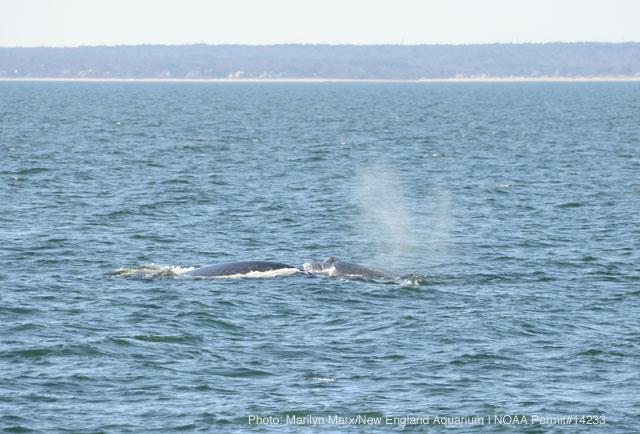Right whale born in cold North Atlantic waters beats odds, survives winter
Wart and her baby were still swimming strong in April, after she gave birth in cold waters off Massachusetts. (Photo courtesy of Marilyn Marx/ New England Aquarium.)
North Atlantic Right whales ordinarily give birth in the balmy waters of Florida and Georgia but in January a whale named Wart gave birth in the cold waters of Cape Cod Bay.
It was the first time in 27 years of data collection that such a northern birth had been observed. Scientists at the New England Aquarium and Whale and Dolphin Conservation were very concerned that the baby might not survive.
But Regina Asmutis-Silvia, senior biologist at the organization Whale and Dolphin Conservation in Plymouth, Mass., said the news is good.
“The aquarium reported a sighting of them on April 18. So the calf was about three months old and it looked really healthy, it looked fat. Mom was feeding — so it’s a really good sign,” she said.
The pair isn’t entirely out of danger. Like all Right whales, they spend a great deal of time at the surface, which can put them in direct conflict with ships and other human activity.
But, for now at least, the problems are more normal, species-specific problems — and not problems from its misplaced birth.
So far, the calf is still drinking its mother’s milk — though it’s not milk like you’d buy at a grocery store.
“It’s kind of … thinking like a mixture of sour cream and cottage cheese and yogurt together. And it’s very rich and fatty like that,” Asmutis-Silvia said.
The rest of the Right whales have since migrated back up to Massachusetts and met Wart and her calf. Scientists are now waiting to see where they pop up next.
Surprisingly, though, the whales were last seen on the west side of Cape Cod Bay — typically they congregate in the middle and east side of the bay. Unfortunately, the west side doesn’t enjoy some of the environmental protections that are provided in the other areas.
“In part, that’s because historic sitings have shown that they prefer to feed in the late winter, early spring. But we had not only Wart and her calf on the west side, we had probably one-third of the Right whale population that was on the west side of the bay at the end of April and beginning of May, and the food was very thick,” Asmutis-Silvia said.
The food was so thick, she said, she went out to a beach near Duxbury and was able to watch a Right whale, just 100 yards off the beach, skim-feeding along the surface.
“That’s just really important for the government agencies to recognize that these animals do use the west side of the bay, and that area does need to be protected,” she said.
